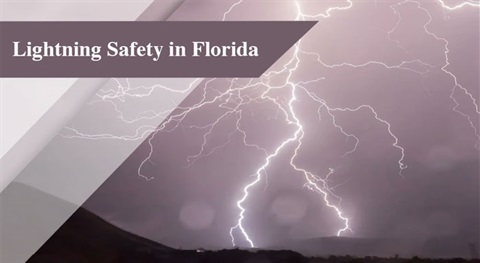Your Guide to Lightning Safety in Florida
Published on July 15, 2025

Did you know Florida experiences more lightning strikes per square mile than any other state in the U.S.? While storms are a common part of life here — especially in the summer — it’s easy to overlook the real risks.
With more lightning activity reported this year, it’s a good time to brush up on safety tips — whether you’re at the park, on the job, or just enjoying the outdoors.
What You Can Do: Lightning Safety Tips
You don’t need to live in fear, but awareness and quick action can save lives. Here are some simple guidelines to follow:
When thunder roars, go indoors.
If you hear thunder, you’re close enough to be struck. Get inside a fully enclosed building or a hard-topped vehicle right away.
Avoid open fields and tall isolated objects.
That includes metal poles, fences, sports equipment, and even umbrellas in open areas.
Don’t shelter under trees.
While it may seem like protection, trees can attract lightning and increase your risk of injury from ground currents or falling limbs.
Stay off water.
Whether you’re boating, swimming, or fishing — wait at least 30 minutes after the last thunderclap before getting back in.
Plan ahead.
Check the weather before outdoor activities. Use weather apps or alerts to monitor storm conditions in real time.
Use the 30-30 rule.
If thunder follows a lightning flash in under 30 seconds, head to shelter and stay there for at least 30 minutes after the last thunder sound.

Lightning Myths vs. Facts
Understanding the truth behind common lightning myths can help keep you safer:
Myth: Lightning never strikes the same place twice.
Fact: Lightning often strikes the same location repeatedly — especially tall or isolated objects like trees, cell towers, and skyscrapers.
Myth: Rubber tires protect you in a car.
Fact: It’s not the rubber tires — it’s the metal roof and frame of the car that direct lightning safely into the ground.
Myth: If you're indoors, you're totally safe from lightning.
Fact: While indoors is safer, you should still avoid using wired electronics, plumbing, or standing near windows during a storm.
Lightning Facts That Might Surprise You:
- Lightning can strike from 10 miles away — even with clear skies above.
- Florida averages over 1.2 million cloud-to-ground lightning strikes annually.
- A majority of lightning victims are involved in outdoor leisure activities and didn’t seek shelter in time.
City Response
The City of Doral continues to monitor severe weather conditions at parks and facilities. Temporary closures may occur during storm activity to ensure public safety. We also work closely with youth programs and sports leagues to encourage safe practices like the 30-30 rule.
Bottom line? Lightning is a natural part of Florida life — but staying alert and informed makes a big difference. Let’s work together to stay safe, rain or shine. Be storm-smart, Doral — and when in doubt, head inside.